 Backend Development
Backend Development PHP Tutorial
PHP Tutorial In-depth explanation of Symfony control layer, in-depth explanation of symfony_PHP tutorial
In-depth explanation of Symfony control layer, in-depth explanation of symfony_PHP tutorialIn-depth and detailed explanation of the Symfony control layer, in-depth and detailed explanation of symfony
This article provides an in-depth analysis of the Symfony control layer. Share it with everyone for your reference, the details are as follows:
The control layer in Symfony contains the code that connects business logic and performance. The control layer is divided into several different parts for different uses.
1. The front-end controller is the only entrance to the application
2. Actions contain application logic. They check the integrity of the request and prepare the data required by the presentation layer
3. Request, response and Session objects provide access to request parameters, response parameters and persistent user data, which are commonly used in the control layer
4. A filter is a part of the code that is executed on every request, whether before or after an action. You can create your own filters.
Front Controller
All WEB requests will be captured by the front-end controller, which is the only entry point for the entire application in a given environment. When the front-end control receives a request, it uses the routing system to match the action name and module name of the URL entered by the user. For example:
http://localhost/index.php/mymodule/myAction
The URL calls the index.php script (that is, the front-end controller), which is understood as: action-myAction, module-mymodule
Working details of the front-end controller
The front-end controller dispatches requests, and he only executes those common and common codes, including:
1. Define core constants
2. Locate the symfony library
3. Load and initialize core framework classes
4. Load configuration information
5. Decode the request URL and obtain the action to be executed and the request parameters
6. Special 404 error if the action does not exist
7. Activate filters (e.g. if authentication is required)
8. Execute filter, first time
9. Execute the action and submit the view
10. Execute filter, second time
11. Output the response.
Default front controller
The default front-end controller is called index.php, which is a simple PHP file in the project's WEB/ directory, as follows:
<?php
define('SF_ROOT_DIR', realpath(dirname(__FILE__).'/..'));
define('SF_APP', 'myapp');
define('SF_ENVIRONMENT', 'prod');
define('SF_DEBUG', false);
require_once(SF_ROOT_DIR.DIRECTORY_SEPARATOR.'apps'.DIRECTORY_SEPARATOR.SF_APP.DIRECTORY_SEPARATOR.'config'.DIRECTORY_SEPARATOR.'config.php');
sfContext::getInstance()->getController()->dispatch();
This file has been introduced before: first define several variables, then introduce the application configuration config.php, and finally call the dispatch() method of sfController (which is the core controller object in the symfony MVC architecture). The last step will be captured by the filter chain.
Call another front-end controller to change the environment
There is a front-end controller for each environment, and the environment is defined in the SF_ENVIRONMENT constant.
Creating a new environment is as easy as creating a new front-end controller. For example, you need a staging environment so that your application can be tested by customers before going online. To create a staging environment, copy web/myapp_dev.php to web/myapp_staging.php, and then change the SF_ENVIRONMENT constant to staging. Now, you can add staging sections to all configuration files needed to set up the new environment, see the following example:
## app.yml staging: mail: webmaster: dummy@mysite.com contact: dummy@mysite.com all: mail: webmaster: webmaster@mysite.com contact: contact@mysite.com ##查看结果 http://localhost/myapp_staging.php/mymodule/index
Batch file
Batch files need to be used when accessing symfony classes and features from the command line or scheduled tasks. The beginning of the batch file is the same as the beginning of the front controller - except for the distribution part of the front controller.
<?php
define('SF_ROOT_DIR', realpath(dirname(__FILE__).'/..'));
define('SF_APP', 'myapp');
define('SF_ENVIRONMENT', 'prod');
define('SF_DEBUG', false);
require_once(SF_ROOT_DIR.DIRECTORY_SEPARATOR.'apps'.DIRECTORY_SEPARATOR.SF_APP.DIRECTORY_SEPARATOR.'config'.DIRECTORY_SEPARATOR.'config.php');
// 添加批处理代码
Actions
Action is the heart of the application because it contains all application logic. They use the model and define variables to the view. When using a request in an application, an action and request parameters are defined in the URL.
Action
Action is a method named executeActionName in the moduleNameActions class (inherited from the sfActions class). It is organized into modules. The module action class is stored in the actions.class.php file in the actions directory.
Only files in the WEB directory can be accessed externally. Front-end control scripts, images, style sheets and JS files are public. Even though methods in PHP are not case-sensitive, symfony does, so don’t forget that action methods must Start with execute in lower case, followed by the action name with the first letter in capital letters.
If the action class becomes large, you should do some decomposition and put the code in the model layer. Actions should be kept as short as possible (a few lines are best), and all business logic should be placed in the model layer.
Optional action syntax
You can have one action and one file. The name of the file is the action name plus Action.class.php, and the class name is the action name plus Action. Just remember that the class inherits from sfAction rather than sfActions.
Get information in action
The action class provides a method to access controller-related information and core symfony objects. The following demonstrates how to use:
<?php
define('SF_ROOT_DIR', realpath(dirname(__FILE__).'/..'));
define('SF_APP', 'myapp');
define('SF_ENVIRONMENT', 'prod');
define('SF_DEBUG', false);
require_once(SF_ROOT_DIR.DIRECTORY_SEPARATOR.'apps'.DIRECTORY_SEPARATOR.SF_APP.DIRECTORY_SEPARATOR.'config'.DIRECTORY_SEPARATOR.'config.php');
class mymoduleActions extends sfActions
{
public function executeIndex()
{
// Retrieving request parameters
$password = $this->getRequestParameter('password');
// Retrieving controller information
$moduleName = $this->getModuleName();
$actionName = $this->getActionName();
// Retrieving framework core objects
$request = $this->getRequest();
$userSession = $this->getUser();
$response = $this->getResponse();
$controller = $this->getController();
$context = $this->getContext();
// Setting action variables to pass information to the template
$this->setVar('foo', 'bar');
$this->foo = 'bar'; // Shorter version
}
}
Context:
A call to sfContext::getInstance() in the front-end controller. In actions, the getContext() method is singleton (i.e. all calls are to the first instance, which is useful for storing an index to the symfony core object associated with a given request).
sfController:控制器对象 (->getController())
sfRequest:请求对象 (->getRequest())
sfResponse:响应对象 (->getResponse())
sfUser:用户Session对象 (->getUser())
sfDatabaseConnection:数据库链接 (->getDatabaseConnection())
sfLogger:日志对象 (->getLogger())
sfI18N:国际化对象(->getI18N())
可以在代码的任何位置放置sfContext::getInstance()。
动作终止
当动作执行完成后会出现各种行为,动作方法的返回值决定视图如何被实施。sfView类的常量经常被指定与模板来显示动作的结果。如果一个默认视图被调用,动作应该以下面的代码结束:
return sfView::SUCCESS;
Symfony将寻找actionNameSuccess.php的模板,这是默认的行为,所以如果你忽略了return语句,symfony也将查找actionNameSuccess.php模板,空动作也将触发同样的行为,如下:
# 将调用indexSuccess.php模板
public function executeIndex()
{
return sfView::SUCCESS;
}
# 将调用listSuccess.php模板
public function executeList()
{
}
如果要调用错误视图,动作将以下面语句结束:
# symfony将查找actionNameError.php模板 return sfView::ERROR;
调用自定义视图
# symfony将查找actionNameMyResult.php模板 return 'MyResult';
如果动作不想调用模板(比如批处理和任务计划cron),可以使用下面的语句
return sfView::NONE;
上面情况下,视图层将被忽略,HTML代码可以直接在动作中输出,symfony提供了一个特殊的方法renderText()来实现。这种情况比较适用于AJAX交互。
public function executeIndex()
{
echo "<html><body>Hello, World!</body></html>";
return sfView::NONE;
}
// 等价方法
public function executeIndex()
{
return $this->renderText("<html><body>Hello, World!</body></html>");
}
有些时候你需要发送空的响应但包含定义的头信息(特别是X-JSON头),定义头通过sfResponse对象,并且放回sfView::HEADER_ONLY常量:
public function executeRefresh()
{
$output = '<"title","My basic letter"],["name","Mr Brown">';
$this->getResponse()->setHttpHeader("X-JSON", '('.$output.')');
return sfView::HEADER_ONLY;
}
如果动作必须呈交特定模板,使用setTemplate()方法来忽略return语句:
$this->setTemplate('myCustomTemplate');
跳向另一个动作
有些情况下,动作以请求一个新的动作作为结束,例如,一个动作处理表单的POST提交在更新数据库后通常会转向到另一个动作。另一个例子是动作别名:index动作经常是来完成显示,所以实际上是跳向了list动作。
有两种方式来实现另一个动作的执行:
① 向前(Forwards)方式
$this->forward('otherModule','otherAction');
② 重定向(Redirection)方式
$this->redirect('otherModule/otherAction');
$this->redirect('http://www.google.cn');
Forward和redirect后面的语句将不会被执行,你可以理解为他们等价于return语句。他们抛出sfStopException异常来停止动作的执行
两者的区别:forward是内部的处理,对用户是透明的,即用户不会感觉到动作发生了变化,URL也不会更改。相反,redirection是动作的真正跳转,URL的改变是最直接的反映。
如果动作是被POST提交表单调用的,你最好使用redirect。这样,如果用户刷新了结果页面,POST表单不会被重复提交;另外,后退按钮也能很好的返回到表单显示页面而不是一个警告窗口询问用户是否重新提交POST请求。
Forward404()方法是一种常用的特殊forward,他跳到“页面无法找到”动作。
经验说明,很多时候一个动作会在验证一些东西后redirect或者forward另一个动作。这就是为什么sfActions类有很多的方法命名为forwardIf(), forwardUnless(), forward404If(), forward404Unless(), redirectIf(), 和 redirectUnless(),这些方法简单地使用一个测试结果参数true(那些xxxIf()方法)或false(那些xxxUnless()方法):
public function executeShow()
{
$article = ArticlePeer::retrieveByPK($this->getRequestParameter('id'));
$this->forward404If(!$article);
}
public function executeShow()
{
$article = ArticlePeer::retrieveByPK($this->getRequestParameter('id'));
$this->forward404Unless($article);
}
这些方法不仅仅是减少你的代码行数,他们还使得你的程序更加易读。
当动作调用forward404()或者其他类似方法,symfony抛出管理404响应的sfError404Exception异常,也就是说如果你想显示404信息,你无需访问控制器,你只是抛出这个异常即可。
模块中多个动作重复代码的处理方式
preExecute()与postExecute()方法是一个模块中多个动作共同的东西。可以在调用executeAction()之前和之后执行。
class mymoduleActions extends sfActions
{
public function preExecute()
{
// 这里的代码在每一个动作调用之前执行
...
}
public function executeIndex()
{
...
}
public function executeList()
{
...
$this->myCustomMethod(); // 调用自定义的方法
}
public function postExecute()
{
// 这里的代码会在每个动作结束后执行
...
}
protected function myCustomMethod()
{
// 添加自己的方法,虽然他们没有以execute开头
// 在这里,最好将方法定义为protected(保护的)或者private(私有的)
...
}
}
访问请求
getRequestParameter(“myparam”)方法常用来获取myparam参数的值,实际上这个方法是一系列请求调用参数仓库的代理:getRequest()->getParameter(“myparam”)。动作类使用sfWebRequest访问请求对象,通过getRequest()访问他们的方法。
sfWebRequest对象的方法
| Method name | Function | Input example |
| Request Information | | |
| getMethod() | RequestObject | Returns sfRequest::GET or sfRequest::POST constants |
| getMethodName() | RequestObject name | 'POST' |
| getHttpHeader('Server') | Given the value of the HTTP header | 'Apache/2.0.59 (Unix) DAV/2 PHP/5.1.6' |
| getCookie('foo') | Specify nameValue of Cookie | 'bar' |
| isXmlHttpRequest()* | Is an AJAX request? | true |
| isSecure() | Is it a SSL request | true |
| Request Parameters | | |
| hasParameter('foo') | Whether the parameters are included in the request | true |
| getParameter('foo') | Specify the value of the parameter | 'bar' |
| getParameterHolder()->getAll() | Array of all request parameters | |
| URI-Related Information | | |
| getUri() | FullURI | 'http://localhost/myapp_dev.php/mymodule/myaction' |
| getPathInfo() | Path information | '/mymodule/myaction' |
| getReferer()** | Where are you from? | 'http://localhost/myapp_dev.php/' |
| getHost() | Hostname | 'localhost' |
| getScriptName() | Front-end controller path and name | 'myapp_dev.php' |
| Client Browser Information | | |
| getLanguages() | List of accepted languages | Array( [0] => fr [1] => fr_FR [2] => en_US [3] => en ) |
| getCharsets() | List of acceptable character sets | Array( [0] => ISO-8859-1 [1] => UTF-8 [2] => * ) |
| getAcceptableContentTypes() | Array of acceptable content types | |
sfActions类提供了一些代理来快速地访问请求方法
class mymoduleActions extends sfActions
{
public function executeIndex()
{
$hasFoo = $this->getRequest()->hasParameter('foo');
$hasFoo = $this->hasRequestParameter('foo'); // Shorter version
$foo = $this->getRequest()->getParameter('foo');
$foo = $this->getRequestParameter('foo'); // Shorter version
}
}
对于文件上传的请求,sfWebRequest对象提供了访问和移动这些文件的手段:
class mymoduleActions extends sfActions
{
public function executeUpload()
{
if ($this->getRequest()->hasFiles())
{
foreach ($this->getRequest()->getFileNames() as $fileName)
{
$fileSize = $this->getRequest()->getFileSize($fileName);
$fileType = $this->getRequest()->getFileType($fileName);
$fileError = $this->getRequest()->hasFileError($fileName);
$uploadDir = sfConfig::get('sf_upload_dir');
$this->getRequest()->moveFile('file', $uploadDir.'/'.$fileName);
}
}
}
}
用户Session
Symfony自动管理用户Session并且能在请求之间为用户保留持久数据。他使用PHP内置的Session处理机制并提升了此机制,这使得symfony的用户Session更好配置更容易使用。
访问用户Session
当前用户的Session对象在动作中使用getUser()方法访问,他是sfUser类的一个实例。sfUser类包含了允许存储任何用户属性的参数仓库。用户属性能够存放任何类型的数据(字符串、数组、关联数组等)。
sfUser对象能够跨请求地保存用户属性
class mymoduleActions extends sfActions
{
public function executeFirstPage()
{
$nickname = $this->getRequestParameter('nickname');
// Store data in the user session
$this->getUser()->setAttribute('nickname', $nickname);
}
public function executeSecondPage()
{
// Retrieve data from the user session with a default value
$nickname = $this->getUser()->getAttribute('nickname', 'Anonymous Coward');
}
}
可以把对象存放在用户Session中,但这往往让人气馁,因为Session在请求之间被序列化了并且存储在文件中,当Session序列化时,存储对象的类必须已经被加载,而这很难被保证。另外,如果你存储了Propel对象,他们可能是“延迟”的对象。
与symfony中的getter方法一样,getAttribute()方法接受第二个参数作为默认值(如果属性没有被定义时)使用。判断属性是否被定义使用hasAttribute()方法。属性存储在参数仓库可使用getAttributeHolder()方法访问,可以使用基本参数仓库方法很简单的清除用户属性:
class mymoduleActions extends sfActions
{
public function executeRemoveNickname()
{
$this->getUser()->getAttributeHolder()->remove('nickname');
}
public function executeCleanup()
{
$this->getUser()->getAttributeHolder()->clear();
}
}
用户Session属性在模板中默认通过$sf_user变量访问,他存储了当前的sfUser对象
<p>
Hello, <?php echo $sf_user->getAttribute('nickname') ?>
</p>
如果只想在当前请求中存储信息,你更应该使用sfRequest类,他也有getAttribute()和setAttribute()方法,只有在请求之间持久存储信息时才适合sfUser对象。
Flash属性
Flash属性是一种短命属性,他会在最近的一次请求后消失,这样可以保持你的Session清洁
$this->setFlash('attrib', $value);
在另一个动作中获取Flash属性:
$value = $this->getFlash('attrib');
一旦传入了另一个动作,Flash属性就消失了,即使你的Session还不过期。在模板中访问flash属性使用$sf_flash对象。
<?php if ($sf_flash->has('attrib')): ?>
<?php echo $sf_flash->get('attrib') ?>
<?php endif; ?>
或者
<?php echo $sf_flash->get('attrib') ?>
Session管理
Symfony的Session处理特性对开发者完全掩盖了客户端与服务端的SessionID存储,当然,如果你非要去改Session管理机制的默认行为也不是不可能,高级用户经常这么干。
客户端,Session被Cookies处理(handle)。Symfony的Session Cookie叫做symfony,可以在factories.yml中修改。
all: storage: class: sfSessionStorage param: session_name: 自定义Cookie名字
Symfony的Session基于PHP的Session设置,也就是说如果希望客户端使用URL参数方式取代Cookies,你必须修改php.ini文件的use_trans_sid参数,不建议这么做。
在服务器端,symfony默认使用文件存储用户Session,可以通过修改factories.yml文件承担class参数来使用数据库存储:apps/myapp/config/factories.yml
all: storage: class: sfMySQLSessionStorage param: db_table: SESSION_TABLE_NAME # 存储Session的表 database: DATABASE_CONNECTION # 数据库的名称 Class名称可以是:fMySQLSessionStorage, sfPostgreSQLSessionStorage和sfPDOSessionStorage;后面是首选方式。 Session超时的修改和调整:apps/myapp/config/settings.yml default: .settings: timeout: 1800 #Session超时 单位秒
动作的安全
动作的执行可以被限定在具有一定权限的用户。Symfony为此提供的工作允许创建安全的应用,用户只有在通过认证之后才能防伪应用的某些特性或部分。设置安全的应用需要两步:定义动作需要的安全和使用具有权限的用户登录。
访问限制
在每个动作执行前都会被一个特定的过滤器来检查当前用户是否具有访问的权限,symfony中权限有两个部分组成:
① 安全动作只有被授权用户可以访问
② 凭证允许分组管理权限
通过创建或者修改config目录下的security.yml文件即可简单的完成安全访问限制。在文件中可以设置某个动作或者所有动作是否需要授权。
Apps/myapp/modules/mymodule/config/security.yml
read: is_secure: off # 所有用户都可以请求Read动作 update: is_secure: on # update动作只能有认证的用户访问 delete: is_secure: on # 同update credentials: admin # 具有admin凭证 all: is_secure: off # 无需授权
用户访问一个需要授权的动作将依据用户的权限:
① 用户已登录并且凭证符合则动作能执行
② 如果用户没有登录则转向默认登录动作
③ 如果用户已登录但凭证不符合则会转向默认的安全动作
转向将根据apps/myapp/config/settings.yml文件来决定
all: .actions: login_module: default login_action: login secure_module: default secure_action: secure
授权
为某用户授权:
class myAccountActions extends sfActions
{
public function executeLogin()
{
if ($this->getRequestParameter('login') == 'foobar') //判断根据具体需求而定
{
$this->getUser()->setAuthenticated(true); //设置用户为已认证
}
}
public function executeLogout()
{
$this->getUser()->setAuthenticated(false); //设置用户为未认证
}
}
在动作中处理凭证:
class myAccountActions extends sfActions
{
public function executeDoThingsWithCredentials()
{
$user = $this->getUser();
// 添加凭证
$user->addCredential('foo');
$user->addCredentials('foo', 'admin'); //添加多个凭证
// 判断是否具有凭证
echo $user->hasCredential('foo'); => true
// 判断是否具有多个凭证
echo $user->hasCredential(array('foo', 'admin')); => true
// Check if the user has one of the credentials
echo $user->hasCredential(array('foo', 'admin'), false); => true
// 删除凭证
$user->removeCredential('foo');
echo $user->hasCredential('foo'); => false
// 删除所有凭证 (被用在注销处理过程中)
$user->clearCredentials();
echo $user->hasCredential('admin'); => false
}
}
如果用户具有'admin'凭证,他就可以访问security.yml文件中设定只有admin可以访问的动作。凭证也经常用来在模板中显示授权信息
<ul>
<li><?php echo link_to('section1', 'content/section1') ?></li>
<li><?php echo link_to('section2', 'content/section2') ?></li>
<?php if ($sf_user->hasCredential('section3')): ?>
<li><?php echo link_to('section3', 'content/section3') ?></li>
<?php endif; ?>
</ul>
sfGuardPlugin插件扩展了session类,使得登录与注销的处理变得简单。
复杂的凭证
在security.yml文件中,可以使用AND或者OR来组合各种凭证,这样就可以建立复杂的业务流和用户权限管理系统。例如,CMS系统后台办公自由具有admin凭证用户访问,文章的编辑必须有editor凭证,发布只能有有publisher凭证的用户,代码如下:
editArticle: credentials: [ admin, editor ] # admin 和 editor publishArticle: credentials: [ admin, publisher ] # admin 和 publisher userManagement: credentials: [[ admin, superuser ]] # admin 或者 superuser
每次添加新的[],凭证之间的关系在AND和OR之间切换,这样可以创建及其复杂的凭证组合关系:
credentials: [[root, [supplier, [owner, quasiowner]], accounts]]
# root 或者 (supplier 和 (owner 或者 quasiowner)) 或者 accounts
注:【和】所有凭证都满足,【或】满足其中的一个凭证。
验证和错误处理方法
验证输入是重复且单调的事情,symfony提供了内置的请求验证系统,使用动作类的方法。
看个例子,当一个用户请求myAction,symfony首先去查找validateMyAction()方法,如果找到了就执行,根据返回结果来决定如何往下走:如果返回真则executeMyAction()被执行,否则handleErrorMyAction()被执行,并且,如果找不到handleErrorMyAction,symfony则去查找普通handleError方法,如果还不存在则简单返回sfView::ERROR并递交myActionError.php模板,看下图:

说明:
① validateActionName是验证方法,是ActionName被请求的第一个查找方法,如果不存在则直接执行动作方法。
② handleErrorActionName方法,如果验证失败则查找此方法,如果不存在则Error模板被显示
③ executeActionName是动作方法,对于动作他必须存在。
看段代码:
class mymoduleActions extends sfActions
{
public function validateMyAction()
{
return ($this->getRequestParameter('id') > 0);
}
public function handleErrorMyAction()
{
$this->message = "Invalid parameters";
return sfView::SUCCESS;
}
public function executeMyAction()
{
$this->message = "The parameters are correct";
}
}
可以在验证方法中加入任何代码,但最终只要返回true或者false即可。因为是sfActions类的方法,所以可以访问sfRequest和sfUser对象,这样将对于输入与上下文验证非常有利。
过滤器
安全处理可以被认为是请求到动作执行之前必须经过的一个过滤器。实际上可以在动作执行前(后)设置任意多个的过滤器。
过滤器链
Symfony实际上将请求处理看作是过滤器链。框架收到请求后第一个过滤器(通常是sfRenderingFilter)被执行,在某些时候他调用下一个过滤器,依次下去。当最后一个过滤器(通常是sfExecutionFilter)执行后,前一个过滤器结束,依次返回去知道rending过滤器。

所有的过滤器均继承自sfFilter类并且都包含了execute()方法,此方法之前的代码在动作(action)之前执行,此方法之后的代码在动作之后执行,看一段代码(下一节中要用到,取名myFilter代码):
class myFilter extends sfFilter
{
public function execute ($filterChain)
{
// 在动作之前执行的代码
...
// 执行下一个过滤器
$filterChain->execute();
// 在动作之后执行的代码
...
}
}
过滤器链在/myapp/config/filters.yml文件中定义:
rendering: ~ web_debug: ~ security: ~ # 在这里插入你自己的过滤器 cache: ~ common: ~ flash: ~ execution: ~
这些声明都没有参数(~在symfony中的意思是null,将采用默认的值),他们都继承自symfony核心定义的参数,symfony为每一个过滤器(除了自定义过滤器)定义了类和参数,他们在$sf_symfony_data_dir/config/filter.yml文件。
自定义过滤器链的方法:
① 设置过滤器的enabled参数为off将禁用过滤器,例如:
Web_debug: enabled: off
你还可以通过settings.yml文件达到此目的,修改web_deug、use_security、cache和use_flash的设置即可,应为每一个默认过滤器都有一个condition参数来自上面的配置。
② 不要通过删除filters.yml文件中的过滤器来禁用该过滤器,symfony将抛出异常
③ 可以自定义过滤器,但无论如何rendering必须是第一个,而execution必须是最后一个
④ 为默认过滤器重写默认类和参数(特别是修改security系统和用户的安全验证过滤器)
创建自定义过滤器
通过创建myFilter的类可以非常简单的常见自定义的过滤器,把类文件放在项目的lib文件夹可以充分利用symfony提供的自动加载特性。
由于动作之间可以互相跳转,因此过滤器链会在每一个请求中循序执行。但更多的时候可能需要是第一次请求的时候执行自定义的过滤器,这时候使用sfFilter类的isFirstCall()方法。看下面代码:apps/myapp/lib/rememberFilter.class.php(例子)
class rememberFilter extends sfFilter
{
public function execute($filterChain)
{
// 通过调用isFirstCall方法保证只执行一次
if ($this->isFirstCall())
{
// 过滤器不直接访问请求和用户对象,你需要使用context对象获取
// You will need to use the context object to get them
$request = $this->getContext()->getRequest();
$user = $this->getContext()->getUser();
if ($request->getCookie('MyWebSite'))
{
// 登入
$user->setAuthenticated(true);
}
}
// 执行下一个过滤器
$filterChain->execute();
}
}
有时候需要在一个过滤器执行之后跳往另一个动作而不是下一个过滤器。sfFilter不包含forward方法,但sfController包含,使用下面的语句:
return $this->getContext()->getController()->forward('mymodule', 'myAction');
sfFilter类有一个initialize方法,在对象创建的时候执行,可以在自定义的过滤器中覆盖此方法以达到更加灵活地设置参数的目的。
过滤器激活及参数
过滤器创建后还必须进行激活,在apps/myapp/config/filters.yml文件中:
rendering: ~ web_debug: ~ security: ~ remember: # Filters need a unique name class: rememberFilter param: cookie_name: MyWebSite condition: %APP_ENABLE_REMEMBER_ME% cache: ~ common: ~ flash: ~ execution: ~
自定义过滤器中的参数可以在过滤器代码中使用getParameter方法获取:
apps/myapp/lib/rememberFilter.class.php
class rememberFilter extends sfFilter
{
public function execute ($filterChain)
{
...
if ($request->getCookie($this->getParameter('cookie_name')))
...
}
}
Condition参数被过滤器链测试来决定是否必须被执行。因此自定义过滤器声明能够依赖一个应用配置。要是过滤器执行,记得在应用的app.yml中加入:
all: enable_remember_me: on
过滤器示例
如果想在项目中包含特定的代码,你可以通过过滤器实现(layout方式需要在每一个应用中都要设置),看下面的代码:
class sfGoogleAnalyticsFilter extends sfFilter
{
public function execute($filterChain)
{
// 在动作之前什么也不做
$filterChain->execute();
// 使用下面的代码修饰响应
$googleCode = '
<script src="http://www.google-analytics.com/urchin.js" type="text/javascript">
</script>
<script type="text/javascript">
_uacct="UA-'.$this->getParameter('google_id').'";urchinTracker();
</script>';
$response = $this->getContext()->getResponse();
$response->setContent(str_ireplace('</body>', $googleCode.'</body>',$response->getContent()));
}
}
这不是一种好的方式,因为在非HTML响应中不适用,只是一个例子而已。
下个例子是转换http请求到https请求
class sfSecureFilter extends sfFilter
{
public function execute($filterChain)
{
$context = $this->getContext();
$request = $context->getRequest();
if (!$request->isSecure())
{
$secure_url = str_replace('http', 'https', $request->getUri());
return $context->getController()->redirect($secure_url);
// We don't continue the filter chain
}
else
{
// The request is already secure, so we can continue
$filterChain->execute();
}
}
}
过滤器广泛地应用于插件,允许全面地扩展应用的特性。
模块配置
一些模块行为依赖配置,要修改他们必须在模块的config目录下建立module.yml并为每一个环境(或者all)定义设置。
看个例子:apps/myapp/modules/mymodule/config/module.yml
all: #对所有环境 enabled: true is_internal: false view_name: sfPHP
Enable参数允许你在模块中禁用所有动作,这样所有动作都将专项到module_disabled_module/module_disabled_action动作(定义在settings.yml)
Is_internal参数定义动作只能内部调用,比如发送邮件只能有另一个动作调用而不是外部的直接调用。
View_name参数定义了view类,类必须继承自sfView。覆盖他后你将可以使用具有其他模板引擎其他的view系统,比如smarty。
希望本文所述对大家基于Symfony框架的PHP程序设计有所帮助。
您可能感兴趣的文章:
- Symfony2之session与cookie用法小结
- Symfony2实现从数据库获取数据的方法小结
- Symfony2实现在controller中获取url的方法
- Symfony2框架学习笔记之表单用法详解
- Symfony2框架学习笔记之HTTP Cache用法详解
- Symfony核心类概述
- 使用symfony命令创建项目的方法
- Symfony模板的快捷变量用法实例
- Symfony2框架创建项目与模板设置实例详解
- Symfony学习十分钟入门经典教程
- 高性能PHP框架Symfony2经典入门教程
- symfony2.4的twig中date用法分析
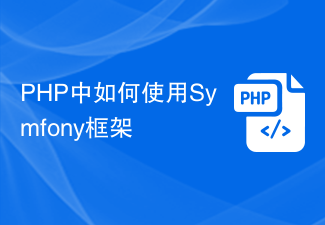 PHP中如何使用Symfony框架Jun 27, 2023 am 11:16 AM
PHP中如何使用Symfony框架Jun 27, 2023 am 11:16 AMSymfony是一种基于PHP语言的高性能、可重复使用的web应用程序框架。它用于构建高质量的web应用程序和服务,并提供多种功能和工具来简化开发过程。Symfony的目标是使Web开发变得更加可用、可重复使用和高效,并且是一个开源框架,它遵循最佳的软件工程实践。对于PHP开发者来说,Symfony框架是一个非常好的选择,因为它提供了丰富而强大的灵活性,可以
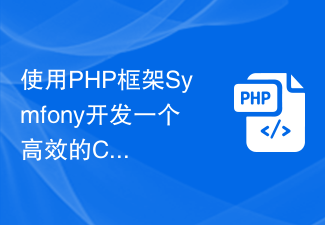 使用PHP框架Symfony开发一个高效的CRM系统Jun 27, 2023 pm 04:17 PM
使用PHP框架Symfony开发一个高效的CRM系统Jun 27, 2023 pm 04:17 PM随着信息技术的快速发展,企业管理系统越来越普及。其中,客户关系管理系统(CRM)是一种非常流行的企业管理系统。当今企业面临的最大挑战之一是如何有效地管理客户关系。开发一个高效的CRM系统就成了一个发展企业的核心任务。本文将介绍如何使用PHP框架Symfony,结合其丰富的功能和文档资料,来开发一款高效的CRM系统。一、了解Symfony框架Symfony是一
 什么是Symfony框架的优势?Jun 03, 2023 am 09:21 AM
什么是Symfony框架的优势?Jun 03, 2023 am 09:21 AMSymfony框架是一款流行的PHP框架,它的优势很多,本文将对于Symfony框架的优势进行探讨。高度的灵活性Symfony框架非常灵活,可以满足各种各样的需求。通过使用它的不同组件,你可以使用你自己的代码来构建自己的块,而无需使用强制性的体系结构。这使得Symfony框架成为开发出高度复杂的应用程序的理想选择。强大的安全性Symfony框架是一个非常安全
 使用Symfony框架实现用户权限管理的步骤Jul 29, 2023 pm 11:33 PM
使用Symfony框架实现用户权限管理的步骤Jul 29, 2023 pm 11:33 PM使用Symfony框架实现用户权限管理的步骤Symfony框架是一个功能强大的PHP开发框架,使用它可以快速开发出高质量的Web应用程序。在开发Web应用程序时,用户权限管理是一个不可忽视的重要部分。本文将介绍使用Symfony框架实现用户权限管理的步骤,并附带代码示例。第一步:安装Symfony框架首先,我们需要在本地环境中安装Symfony框架。可以通过
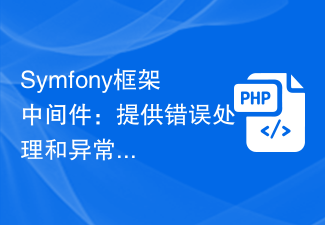 Symfony框架中间件:提供错误处理和异常管理功能Jul 28, 2023 pm 01:45 PM
Symfony框架中间件:提供错误处理和异常管理功能Jul 28, 2023 pm 01:45 PMSymfony框架中间件:提供错误处理和异常管理功能当我们在开发应用程序时,经常会遇到错误和异常的情况。为了优化用户体验和提供更好的开发者工具,Symfony框架提供了强大的错误处理和异常管理功能。在本文中,我们将介绍Symfony框架中间件的使用和示例代码。Symfony框架中的错误处理和异常管理功能主要通过中间件来实现。中间件是一个特殊的功能组件,用于在
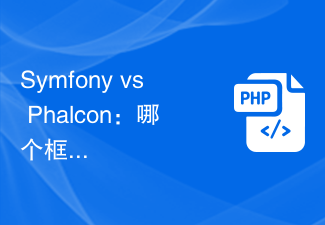 Symfony vs Phalcon:哪个框架更适合开发大规模社交媒体应用?Jun 18, 2023 pm 10:09 PM
Symfony vs Phalcon:哪个框架更适合开发大规模社交媒体应用?Jun 18, 2023 pm 10:09 PM随着社交媒体应用的不断增长,越来越多的开发人员开始关注哪个框架最适合用来构建这样的应用。Symfony和Phalcon是两个非常受欢迎的PHP框架,它们都有着成熟的社区和强大的开发工具。但是如果你需要开发大规模的社交媒体应用程序,那么哪个框架更适合呢?Symfony是一个成熟的PHP框架,它提供了丰富的功能和工具,可以帮助你快速构建大型应用程序。Symfon
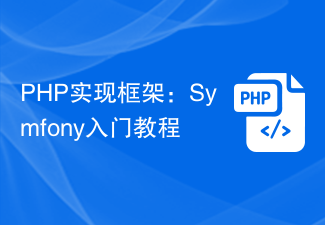 PHP实现框架:Symfony入门教程Jun 18, 2023 pm 01:18 PM
PHP实现框架:Symfony入门教程Jun 18, 2023 pm 01:18 PMSymfony是一种基于PHP语言开发的Web开发框架,它提供了一系列工具和组件,可以帮助开发者快速开发高质量的web应用程序。Symfony框架在Web应用程序当中被广泛使用,它允许开发者构建具备高度可扩展性和灵活性的应用程序。在本文中,我们将向您介绍Symfony框架,并提供一些有关如何使用Symfony框架构建Web应用程序的简单指导。安装Symfon
 使用Symfony框架实现文件上传和下载的步骤Jul 28, 2023 pm 01:33 PM
使用Symfony框架实现文件上传和下载的步骤Jul 28, 2023 pm 01:33 PM使用Symfony框架实现文件上传和下载的步骤在现代的Web应用程序中,文件上传和下载是一项常见的功能需求。Symfony框架为我们提供了一种简单而强大的方式来实现文件上传和下载功能。本文将介绍如何使用Symfony框架来实现文件上传和下载功能,并提供相应的代码示例。步骤一:安装Symfony框架首先,我们需要在本地环境中安装Symfony框架。可以通过Co


Hot AI Tools

Undresser.AI Undress
AI-powered app for creating realistic nude photos

AI Clothes Remover
Online AI tool for removing clothes from photos.

Undress AI Tool
Undress images for free

Clothoff.io
AI clothes remover

AI Hentai Generator
Generate AI Hentai for free.

Hot Article

Hot Tools

mPDF
mPDF is a PHP library that can generate PDF files from UTF-8 encoded HTML. The original author, Ian Back, wrote mPDF to output PDF files "on the fly" from his website and handle different languages. It is slower than original scripts like HTML2FPDF and produces larger files when using Unicode fonts, but supports CSS styles etc. and has a lot of enhancements. Supports almost all languages, including RTL (Arabic and Hebrew) and CJK (Chinese, Japanese and Korean). Supports nested block-level elements (such as P, DIV),

MantisBT
Mantis is an easy-to-deploy web-based defect tracking tool designed to aid in product defect tracking. It requires PHP, MySQL and a web server. Check out our demo and hosting services.

SAP NetWeaver Server Adapter for Eclipse
Integrate Eclipse with SAP NetWeaver application server.

Atom editor mac version download
The most popular open source editor

MinGW - Minimalist GNU for Windows
This project is in the process of being migrated to osdn.net/projects/mingw, you can continue to follow us there. MinGW: A native Windows port of the GNU Compiler Collection (GCC), freely distributable import libraries and header files for building native Windows applications; includes extensions to the MSVC runtime to support C99 functionality. All MinGW software can run on 64-bit Windows platforms.






